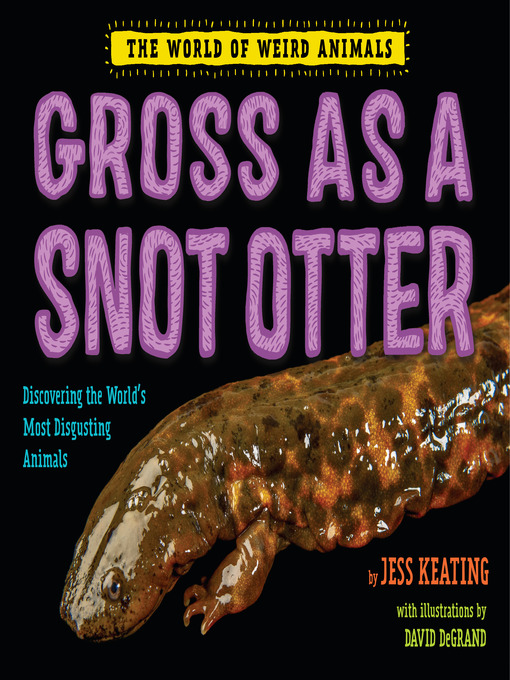The creators of Pink Is for Blobfish are back, and they've brought 17 of their most revolting friends: there are slippery, slimy snot otters, gulls that projectile-vomit on command, fish that communicate via flatulence, and chipmunks that cultivate healthy forests by pooping a trail of seeds wherever they go. But there's more to these skin-crawling creatures than meets the eye, and as zoologist Jess Keating explains, sometimes it's the very things that make us gag that allow these animals to survive in the wild.
The perfect combination of yuks, yucks, and eureka!'s, this latest installment in the World of Weird Animals series will inspire budding scientists and burp enthusiasts alike!
-
Creators
-
Series
-
Publisher
-
Release date
October 29, 2019 -
Formats
-
Kindle Book
-
OverDrive Read
- ISBN: 9781524764524
-
-
Languages
- English
-
Levels
- ATOS Level: 6.3
- Lexile® Measure: 980
- Interest Level: K-3(LG)
- Text Difficulty: 5-7
-
Reviews
-
Kirkus
September 1, 2019
What makes an animal gross? In their latest entry in their World of Weird Animals series, Keating and DeGrand present 17 more curious creatures, this time animals that may inspire disgust. The Canadian-based zoologist-turned-author has found repulsive examples from around the world. These include slime-covered sea-dwellers, farting fish, gulls who projectile-vomit, even a Spanish newt that can extend its barbed ribs out through its poisonous skin. Zombie worms from ocean depths, tree frogs (who occasionally turn up in Australian toilets), and burrowing South American caecilians will likely be unfamiliar; common housefly larvae (maggots), Siberian chipmunks, and slobbery giraffes have surprisingly unsavory aspects. Poop protects a Marabou stork's legs and provides meals for dung beetles. Mucus protects snot otters and parrotfish. Fully-formed toadlets hatch from a Surinam toad mother's back. This title follows the pattern of previous ones: Spread by garishly colored spread, readers are introduced to weird and wonderful creatures with a photograph, two short paragraphs of intriguing information, and fast facts: common and Latin names, size, diet, habitat, and predators and threats. Words and phrases that may not be familiar (think "chytridiomycosis," "cutaneous respiration," "eviscerate," "ocean acidification," and "pharyngeal teeth") are bolded in the text and defined in a glossary. Cartoon illustrations and a lively design complete the package. With no index or page numbers, this is fact-full but best for browsing. Book-bait for middle-grade readers that oozes eww appeal. (Informational picture book. 7-11)COPYRIGHT(2019) Kirkus Reviews, ALL RIGHTS RESERVED.
-
School Library Journal
October 1, 2019
K-Gr 3-Snot otters use their mucus-covered skin to repel infections and predators. Siberian chipmunks rub their fur with the dead flesh of snakes to scare away predators. Facts such as these fill Keating's latest title in the "The World of Weird Animals" series. Combining fascinating animal facts with photographs and amusing illustrations makes for an informative and rather disgusting book that young readers will eagerly snatch from the shelf. The bright colors and large photographs are eye-catching, if not exactly beautiful. Difficult vocabulary words are highlighted and defined in the glossary at the end of the book. A bibliography would have been useful, but young readers won't miss it. VERDICT A first purchase where Keating's other books are popular or animal books are in demand.-Heidi Grange, Summit Elementary School, Smithfield, UT
Copyright 2019 School Library Journal, LLC Used with permission.
-
Booklist
September 15, 2019
Grades 1-3 Having delighted readers with pink and adorable animals in Pink Is for Blobfish (2016) and Cute as an Axolotl (2018), Keating turns to mucus, slime, vomit, poop, and more disgusting anomalies in the animal world. Whether explaining how snot otters (aka hellbenders) use mucus to protect themselves from infection; fulmar gulls projectile vomit a sticky, oily substance to ward off attackers; or marabou storks poop on their own legs to lower their body temperature, the author sticks to her tried-and-true format. Double-page spreads feature a large color photo of the animal, a light-hearted description, fast facts (e.g., its size, diet, habitat, and predators), and a silly cartoon and fact combo, such as why herring use farts to communicate. The surprises are not the more unusual animals but how seemingly beloved animals, like the giraffe and Siberian chipmunk, have a gross side, too. A concluding section on The Science of ?Eww!' dissects how, as humans evolved, disgusting appearances and smells kept them safe. The weird and wonderful combination of each animal is once again a winner.(Reprinted with permission of Booklist, copyright 2019, American Library Association.)
-
Languages
- English
Levels
- ATOS Level:6.3
- Lexile® Measure:980
- Interest Level:K-3(LG)
- Text Difficulty:5-7
Loading
Why is availability limited?
×Availability can change throughout the month based on the library's budget. You can still place a hold on the title, and your hold will be automatically filled as soon as the title is available again.
The Kindle Book format for this title is not supported on:
×- - Kindle 1
- - Kindle 2
- - Kindle DX
- - Kindle Keyboard
- - Kindle 4
- - Kindle Touch
- - Kindle 5
- - Kindle Paperwhite
- - Kindle 7
- - Kindle Voyage
Read-along ebook
×The OverDrive Read format of this ebook has professional narration that plays while you read in your browser. Learn more here.



